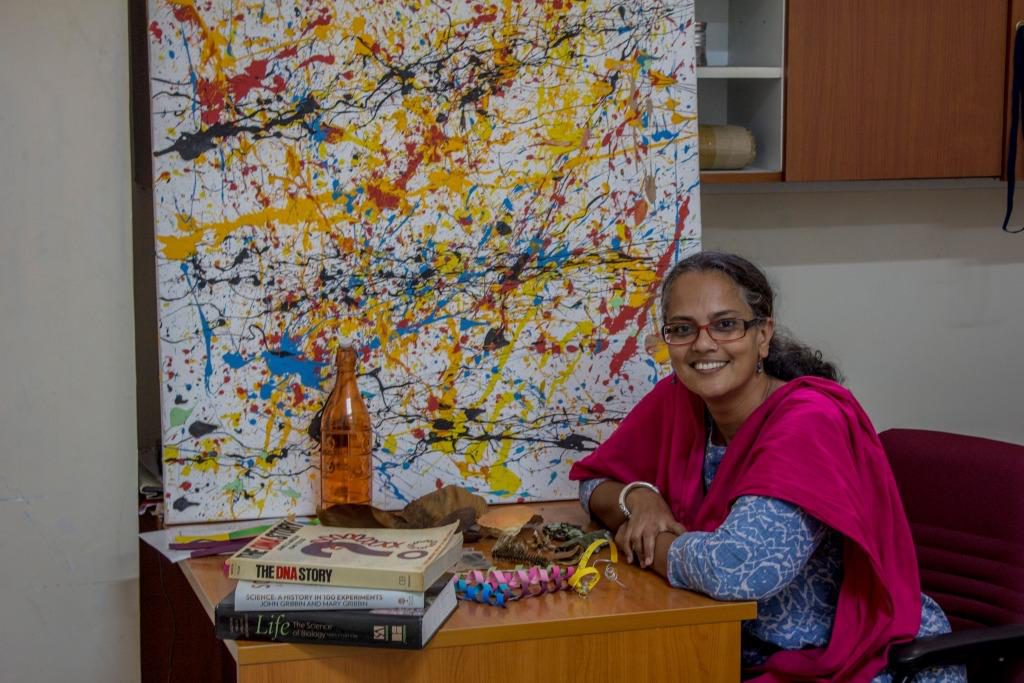An undergraduate (UG) instructor reflects on her experience teaching IISc’s students

My students often complain that I answer their questions with more questions. I am convinced that they know why I do it, and aren’t serious in their protests. Here are some examples:
Scene 1: First year UG lab, Subject: Microbiology
M was comparing growth curves of E. coli grown at 37°C with those grown at 40°C. He was surprised to find that the curve was steeper at 40°C, suggesting that the bacteria were increasing in numbers faster at that temperature. This was unexpected. After all, E. coli live in the human colon, where the temperature is about 37°C; so shouldn’t that be the optimum temperature for their growth? The discussion at the end of the lab led to further questions: do these bacteria have some digestive enzymes that get activated only at 40°C? Are bacteria growing faster at 40°C because the culture media gets digested better at that temperature, while the food source in the colon needs 37°C? Also, is growing faster a “good thing”?
Scene 2: First year UG lab, Subject: Biomolecules
K predicted that because a grapefruit is sour and an orange is sweet, the latter has more reducing sugars. She did a qualitative sugar assay, which showed that there was little to no difference between the reducing sugars in the two fruits. The conversation afterwards dwelled on the possibility that the extra sourness in a grapefruit is because of the presence of an acid, rather than the lack of reducing sugars. Also, a literature search led K to understand that both fruits contain vitamin C, which independently reacts with the reagent she was using, thus confounding the results. She now believes that the experiment must be repeated using a different assay.
……..
I came to work in IISc on 12 August 2014 as a biology instructor in the UG programme, one of the most prestigious science institutes in the country. While it has always been coveted for its engineering and basic sciences departments, the country had not yet become aware of it as a place for undergraduate education. The UG programme was a new experiment for the Institute, and the batch of 2014 was only its fourth.
I genuinely enjoy working with undergraduates. I love being surrounded by their excitement and marvel
The position of an ‘instructor’ was a strange one. My brief was to handle the labs, to design experiments to go with the theory being taught in the classes. I knew I wouldn’t get to do any research, nor teach theory classes. This latter was unfortunate, but I thought, “I’ll anyway get to teach students in the labs.” I was to make sure, with the help of teaching assistants, that the equipment and material for those experiments was available and in good condition, and then conduct experiments I had designed. Although a conversation with (and approval of) the theory teacher – always one of the professors at IISc – was necessary, I had quite a bit of freedom. Besides, I genuinely enjoy working with undergraduates. At this stage of their lives, they are still not cynical. I love being surrounded by their excitement and marvel.
The Student
There is a general feeling that for someone with a PhD degree and serious postdoctoral experience, being a UG instructor would be 1) a cakewalk, and 2) somewhat boring. A year spent teaching undergrads at IISER (Pune) had rid me of such misconceptions. This job is neither of these.
I will try to explain what happens in a casual chat with a UG student. If you start talking science, (not attendance or marks), you might as well say goodbye to that coffee you were stepping out to grab. You will never be done. Here’s how some conversations have started for me: “Ma’am, I found a dead crow near Jubilee Garden. Do we have material for taxidermy?” “Ma’am, we were observing this colony of red weaver-ants, but we forgot to cover it over the night, and now the box is empty.” “Ma’am, remember that green water I collected from the pond in the nursery… It’s not cyanobacteria. It’s Euglena. Can we extract chloroplasts from them?” “Ma’am, I made a spider robot. I wanted to see if having eight legs is better for moving along a web than having six legs… but the legs are too heavy, and now it refuses to move.”
UG students will keep you on your toes. It is not enough to think you know something; you must be able to explain it till the logic becomes clear to them. No hand waving will work. A conversation with a first-year undergrad that started with looking at bacterial cells under a microscope can quickly move to… different staining methods to antibodies to how they are made to animal ethics and to electron microscopy. The same conversation can branch out into Green Fluorescent Protein, and how to make fusion proteins and to the misfortune of Douglas Prasher. You will find yourself moving from lab-bench to the white-board, drawing graphs and checking facts on the desktop computer until either it is time for you to go home, or for them to go get a snack before their mess closes. There is nothing safe or easy about talking to a brilliant undergrad… and there is no dearth of those in IISc.
The Teacher
There is no doubt that it’s the students who make IISc’s UG programme different from others. However, I like to believe that it is also the instructors. IISc is somewhat unique in having an “instructor” position. I am not sure the “powers that be” really understand why the decision to create this position was so right. And that’s unfortunate. An instructor is an experienced researcher who wants to engage in teaching undergrads. She has a lab at her disposal, and her time is dedicated to engaging students in scientific activities. Some may think, quite unwisely, that this is her lack of ambition. I want to state, and I am sure my colleagues will agree, that this is what we want to do.
UG students will keep you on your toes. It is not enough to think you know something; you must be able to explain it till the logic becomes clear to them
Is it enough to just “want” to teach, though? It is equally important to ask what a teacher’s role really is in this age of information. Every teacher must ask, “What can I offer a student that he can’t find on the internet? Why should a student, who can easily watch a MOOC or a YouTube video sitting in her room, come and attend my class?” The answer must be: “To learn how to think.” If it is not, we are wasting their time and ours. It is the teacher’s responsibility to convert that mark-seeking machine into a thinking researcher. Here is where an instructor has an influential role to play. Science students must experiment. No matter how much literature they read, they won’t intuitively know that water kept in an open beaker becomes more acidic overnight. They won’t learn what a struggle it is to observe mating behavior of guppies till they watch them at it. For that, they need an instructor who will needle them with questions and show them the way around the lab to learn to find answers for themselves.
And The Rest
Some of us lift another responsibility that goes beyond science. Without being asked. This is even more relevant today. Many of our students need help to deal with life in IISc and learning how to make a life in science. Mental health, emotional breakdowns and want of an adult who will listen… these are common concerns. Instructors are willing to help, but are untrained. My colleagues and I often have a tremendous feeling of helplessness, hopelessness. We have tried to help students in great distress, but we aren’t equipped. It will be extremely useful if the Institute arranged for the instructors to be trained to counsel teenage students.

And there’s one other thing that IISc could do to get more out of instructors. An instructor’s position is the most underrated and underutilised position in the Institute. There are three months in a year when we are relatively free. We could conduct workshops for school and college teachers. We could take the responsibility of creating the UG handbook. We could interview lab TAs; after all, TAs work under the instructors’ supervision.
My reflections come from my experience of having been an instructor for five years. And now my time in IISc is nearing its end. These were great years from the perspective of my interaction with students. I made changes in the lab designs. It took me four years to say, “Yes, this is how this practical should be done”. Four years to learn how to convey the excitement of discovery. I had to learn to remain detached without being impersonal, to dodge premature questions, to cut short lengthy arguments, to curb enthusiasm heading toward a dead-end. The nature of an undergrad is to play. The paths they explore may end up going nowhere, as is natural. It becomes an important task to give direction and structure to their fast-flowing curiosity.
In my students I see certain fearlessness, confidence, an assurance about the fairness of the world. I am humbled by it, but also know how fragile it is. All one can do is to prepare them for what may come, and hope their wonderment remains intact.
Narmada Khare has taught biology in IISc’s UG programme for the past five years




